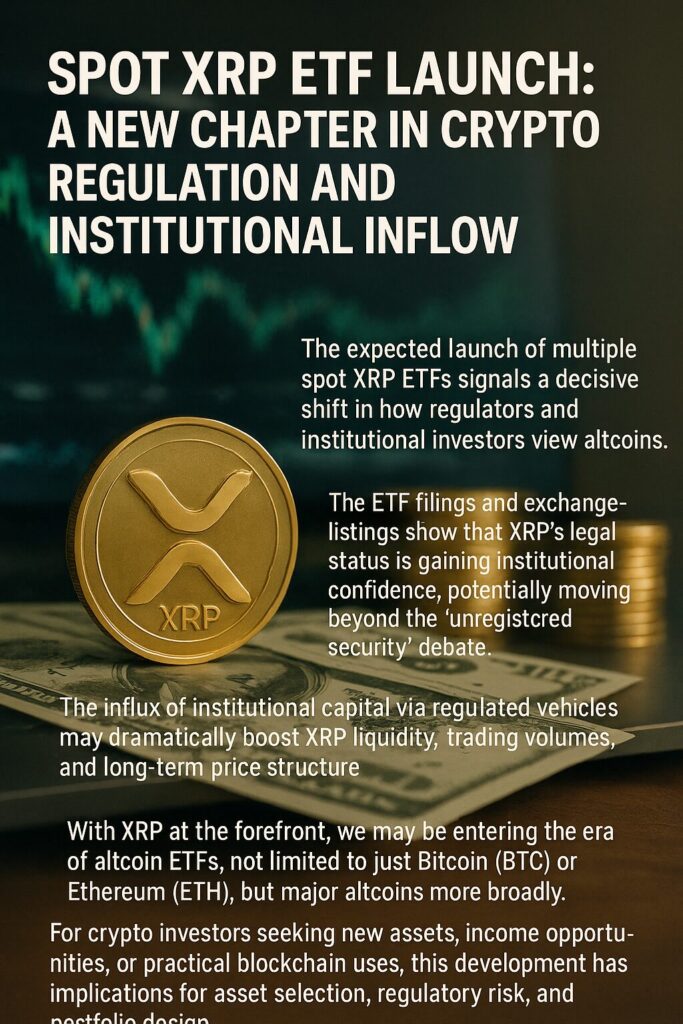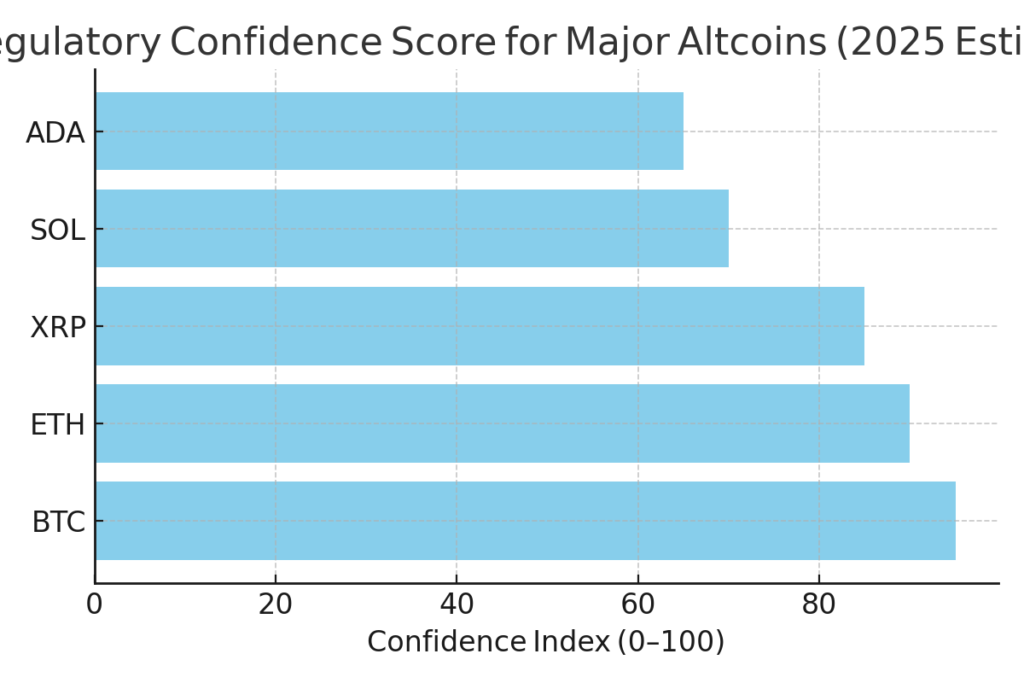
Key Points :
- The expected launch of multiple spot XRP ETFs signals a decisive shift in how regulators and institutional investors view altcoins.
- The ETF filings and exchange-listings show that XRP’s legal status is gaining institutional confidence, potentially moving beyond the “unregistered security” debate.
- The influx of institutional capital via regulated vehicles may dramatically boost XRP liquidity, trading volumes, and long-term price structure.
- With XRP at the forefront, we may be entering the era of altcoin ETFs, not limited to just Bitcoin (BTC) or Ethereum (ETH), but major altcoins more broadly.
- For crypto investors seeking new assets, income opportunities, or practical blockchain uses, this development has implications for asset selection, regulatory risk, and portfolio design.
1. Legal Clarity and Market Trust – The XRPs “Non-Security” Proofpoint
The news that spot-XRP ETFs are likely to debut in the U.S. market represents more than a new product. The native token of Ripple Labs, XRP, has long been entangled in a legal dispute with the U.S. Securities and Exchange Commission (SEC) over whether it constitutes an unregistered security. Market participants now interpret the ETFs’ filings and regulatory posture as a de facto affirmation of XRP’s non-security status. The ETF application process includes assessments of liquidity, market manipulation resistance, custody and transparency—factors that regulators use to gauge suitability for public investment. Thus, if spot-XRP ETFs are approved, it signals institutional-grade trust in XRP’s regulatory standing.
The broader implication is that the industry’s “is this a security or not?” question may be resolved more firmly, at least for XRP, which opens a precedent for other altcoins. As the article points out, the approval of an ETF isn’t just creating a new product—it is institutionalizing an asset class.
For investors seeking new crypto assets and income streams, the regulatory risk factor has often been a major dampener. With this shift, XRP may be seen as less “wildcard” and more “institution-ready.” That doesn’t mean risk vanishes—custody, market structure, and tokenomics still matter—but the barrier to institutional access is much lower.
2. Institutional Capital Inflow & Liquidity Explosion

One of the most important practical consequences of spot-XRP ETF approval is the expected wave of institutional capital that can more safely access XRP via regulated vehicles. Historically, pension funds, insurance companies, asset managers and other large institutions have avoided direct crypto investment because of custody risk, regulatory ambiguity and lack of familiar product wrappers. ETFs solve many of those issues.
The article highlights that five spot-XRP ETFs have reportedly completed preparation, which suggests competition among issuers, and hence better investor terms (lower fees, better service) and potentially faster adoption. The liquidity implications are large: when institutional funds deploy at scale, trading volumes rise, bid-ask spreads tighten, market structure deepens, and token price becomes less subject to idiosyncratic swings.
For a crypto investor looking for new income sources, this means XRP may transition into a “blue-chip altcoin” status. It might no longer be just speculative, but accepted as a core portfolio component with regulated access. However, timing and execution matter: the flow won’t be instantaneous, and markets may price in expectations ahead of actual flows, meaning volatility will likely remain high in the runway phase.
It’s also worth noting that many analysts expect the launch window to be mid-November 2025, in the U.S. context, giving the roadmap some concreteness.

3. The Dawn of the Altcoin ETF Era

Up until now, the major regulated crypto ETF narrative centered on Bitcoin and to a lesser extent Ethereum. The move to approve a spot-XRP ETF effectively opens the door for other major altcoins to obtain the same treatment. The article comments that this is not just about XRP—it’s about the category of altcoins stepping into regulated mainstream financial products.
From an investor’s viewpoint, this means a strategic shift: rather than only focusing on BTC/ETH, the next wave of alpha may come from altcoins that meet regulatory, liquidity and use-case criteria. For example, tokens with real-world utility, strong partnerships, institutional custody features and regulatory clarity will stand out. XRP already ticks many of these boxes (notably its cross-border payment use-case).
As altcoin ETFs proliferate, portfolio diversification strategies will evolve. Investors may allocate a portion of their holdings to regulated altcoin ETFs rather than direct token exposure, reducing custody and self-wallet risk. At the same time, practical blockchain applications—such as payments, tokenised assets, DeFi on regulated rails—can gain momentum as more institutional capital participates.
4. Practical Implications for Crypto Asset-Seekers and Income-Hunters
For our audience—those seeking new crypto assets, income opportunities, and real-world blockchain utilisation—what does all this mean?
a. Regulatory risk mitigation
When you invest in a token like XRP that is moving into a regulated wrapper (ETF), some risks associated with enforcement, classification and custody are reduced. That means you can allocate part of your portfolio to tokens with more established regulatory pathways.
b. Liquidity and market structure improvement
Higher institutional involvement tends to improve market depth, reduce slippage, and enhance exit / entry planning for mid-size investors. If you’re targeting income or yield, better market structure makes token-based approaches more feasible.
c. Use-case validation matters
Tokens with strong, real-world use cases (payments, settlements, enterprise adoption) are more likely to be embraced in regulated products. For instance, XRP’s payment rails history helps its case. When evaluating new assets, weigh not only hype but practical partnership, utility and regulatory alignment.
d. Income and yield design
While ETFs themselves may not offer “yield” in the traditional sense (unless distributions are paid or staking is enabled), more regulated exposure enables strategies such as lending, institutional custody, derivatives overlay, or structured products. Investors could consider pairing a spot ETF position with yield-generating mechanisms in the aftermarket (assuming one’s jurisdiction allows).
e. Timing and opportunistic entry
When an ETF launches, there can be a “first-mover” spike in demand—both institutional and retail. For investors seeking upside, studying the launch timeline (S-1 effectiveness, exchange listing notice, settlement readiness) gives an edge. The article underlines that not all filings or DTCC listings equal final approval—so caveats apply.
5. Risks, Caveats and Strategic Considerations
Despite the optimism, investors should remain mindful of residual risks:
- Regulation is not final: Even if spot-XRP ETFs are launched, regulatory regimes can change, and other tokens might still face classification uncertainty.
- Price run-up risk: A lot of upside may already be priced in ahead of the official launch. Rapidly rising expectations could lead to a short-term pullback.
- Market saturation: If multiple ETFs launch simultaneously, competition might dilute first-mover advantage or increase fee pressure.
- Tokenomics and fundamental support: A token must still stand on its merits. For XRP, while payments use-case is prominent, broader adoption and ecosystem growth will determine long-term value.
- Macro-crypto correlation: Even regulated crypto products can be impacted by broader risk-off conditions, interest rate changes, and macro liquidity.
- Custody and redemption mechanisms: For ETFs to function well, the underlying token custody, creation/redemption mechanics and market arbitrage must operate smoothly. If these are faulty, ETF performance may lag.
Conclusion
The pending launch of spot-XRP ETFs marks a watershed moment for the crypto asset class. It’s not simply about one token—XRP—it’s about the broader transition of crypto from fringe speculative assets to regulated financial instruments accessible to mainstream investors. For crypto-asset seekers and income-hunters, this development offers a compelling opportunity: a token with a strong use-case, regulatory clarity emerging, and institutional access opening up. However, smart investing requires clarity about timing, fundamentals, and risk. As altcoin ETFs begin to proliferate, assets with clear utility, strong liquidity, and regulatory alignment will lead the next wave of growth. For investors building exposure now, approaching with discipline—balancing potential upside with risk management—will help navigate this new chapter in blockchain finance.

